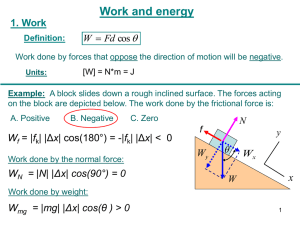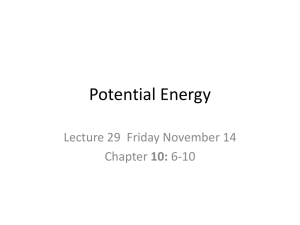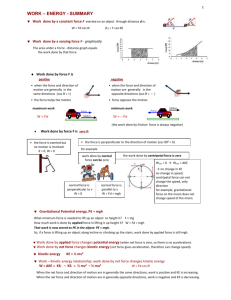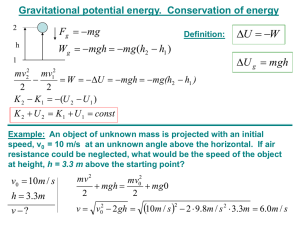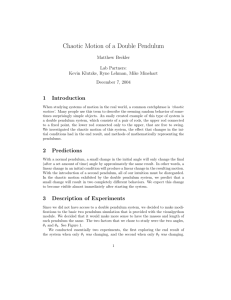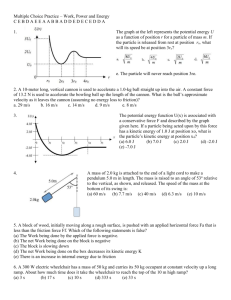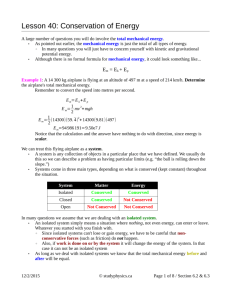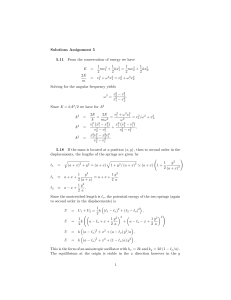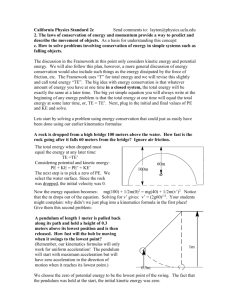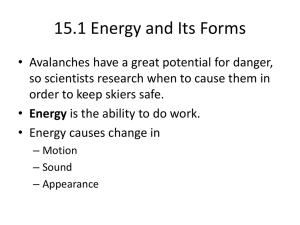lecture07
advertisement
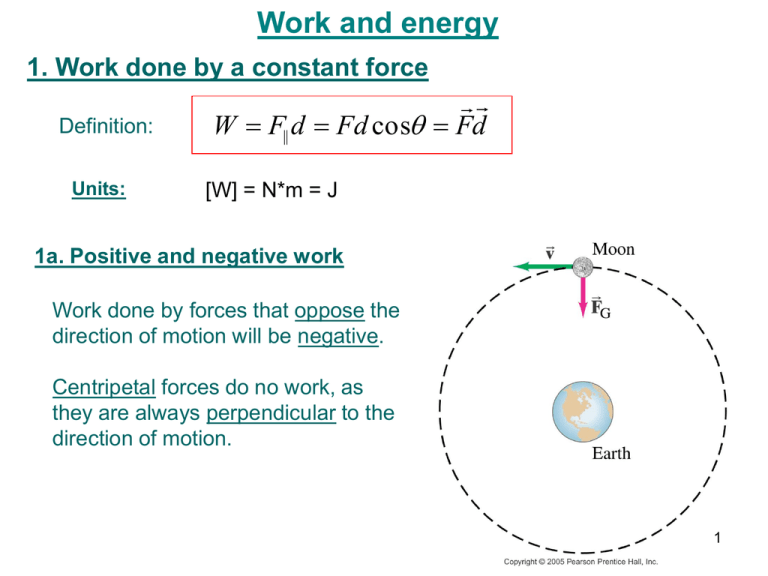
Work and energy 1. Work done by a constant force Definition: Units: W F|| d Fd cos Fd [W] = N*m = J 1a. Positive and negative work Work done by forces that oppose the direction of motion will be negative. Centripetal forces do no work, as they are always perpendicular to the direction of motion. 1 Example: An object of unknown mass is displaced 5 m by a constant force F = 20 N as shown below (angle θ=60º). Force of friction is f = 6 N. Find the work done by each of these forces and the total work. y Fy F Fx f a x 5m WF Fx x ( F cos ) x (20 N )(cos600 )(5 m) 50 J W fr f (cos1800 ) x fx (6 N )(5 m) 30 J Wtot F cos f x 20N cos600 6 N (5m) 20 J Find mass of the object if the coefficient of kinetic friction is 0.5. 2 Example: A block slides down a rough inclined surface. The forces acting on the block are depicted below. The work done by the frictional force is: A. Positive N B. Negative f C. Zero y Wf = |fk| |Δx| cos(180°) = -|fk| |Δx| < 0 x mg Work done by the normal force: WN = |N| |Δx| cos(90°) = 0 0 < θ < 90° Work done by weight: Wmg = |mg| |Δx| cos(θ ) > 0 3 2. Work kinetic energy principle v22 v12 2a( x2 x1 ) m v22 m v12 m a( x2 x1 ) Fd 2 2 Definition: K m v22 m v12 W 2 2 m v2 W=K2 - K1 2 Example: An 80-g arrow is fired from a bow whose string exerts an average force of 100 N on the arrow over a distance of 49 cm. What is the speed of the arrow as it leaves the bow? m = 80 g F = 100 N d = 49 cm v1= 0 v2 - ? W Fd K1 0 m v22 K2 2 m v22 Fd 2 2 Fd v2 m 2 100N 49 102 m v2 35m / s 3 80 10 kg 4 Example: Two blocks (m1=2m2) are pushed by identical forces, each starting at rest at the same start line. Which object has the greater kinetic energy when it reaches the same finish line? 1. Box1 2. Box 2 3. They both have the same kinetic energy Same force, same distance Same work Same change in kinetic energy Example: A ball is dropped and hits the ground 50 m below. If the initial speed is 0 and we ignore air resistance, what is the speed of the ball as it hits the ground? We can use kinematics or… the WKE theorem Work done by gravity: mgh W K mgh 12 mv2 0 v = 2gh = 2(9.8 m / s 2 )(50 m) = 31 m / s 5 3.Gravitational potential energy. Conservation of energy 2 h 1 Fg m g Definition: Wg m gh m g(h2 h1 ) U W U g mgh m v22 m v12 W U m gh m g(h2 h1 ) 2 2 K 2 K1 (U 2 U 1 ) Conservation of mechanical energy: K1 U1 K 2 U 2 E const K U E 0 For closed isolated system 6 Example: A box of unknown mass and initial speed v0 = 10 m/s moves up a frictionless incline. How high does the box go before it begins sliding down? K1 U1 K 2 U 2 m 1 2 Only gravity does work (the normal is perpendicular to the motion), so mechanical energy is conserved. mv02 0 0 mgh 2 v02 10m / s 5m h 2 g 2 10m / s 2 We can apply the same thing to any “incline”! Turn-around point: where K=0 E K U E K U E K U v=0 h 7 Example: A roller coaster starts out at the top of a hill of height h. How fast is it going when it reaches the bottom? m v2 m gh 2 Einitial E final U initial mgh K final m v2 2 h v 2gh Example: An object of unknown mass is projected with an initial speed, v0 = 10 m/s at an unknown angle above the horizontal. If air resistance could be neglected, what would be the speed of the object at height, h = 3.3 m above the starting point? v0 10m / s h 3.3m v ? m v2 m v02 m gh m g0 2 2 v v02 2 gh 10m / s 2 2 9.8m / s 2 3.3m 6.0m / s 8 Example: Pendulum (Conservation of energy) Only weight of the pendulum is doing work; weight is a conservative force, so mechanical energy is conserved: K U const θ0 θ0 L m K 0 U max K 0 U max U m gh m v2 K 2 K max U min The angle on the other side is also θ0! 9 Example: Pendulum (Conservation of energy) The pendulum with a mass of 300 g is deviated from the equilibrium position B to the position A as shown below. Find the speed of the pendulum at the point B after the pendulum is released. A. Energy of the pendulum at the point A: U A mgh KA 0 A B B. Energy of the pendulum at the point B: UB 0 h 20cm v m v2 KB 2 C. Conservation of energy: KA U A KB UB m v2 0 m gh 0 2 v 2 gh 2 9.8m / s 2 0.2m 1.97 m / s 10 4.Hook’s Law (elastic forces) F kx Fext Fext Fext F Potential energy U Wby system Wext 12 kx2f 12 kxi2 U 12 kx2 C 11 Example: A box of mass m = 0.25 kg slides on a horizontal frictionless surface with an initial speed v = 10 m/s. a) How far will it compress the spring before coming to rest if k = 2500 N/m? m = 0.25 kg k = 2500 N/m v = 10 m/s x Work-kinetic energy theorem: W = ΔKE Wext 12 kx2 K 12 mv2 0 1 2 m xv k kx mv 2 2 1 2 0.25kg x 10m / s 2500N / m b) If the initial speed of box is doubled and its mass if halved, how far would the spring be compressed? 0.1m x2 v2 x1 v1 m2 2 m1 12 5. Conservative and nonconservative forces •Forces such as gravity or the elastic force, for which the work does not depend on the path taken but only on the initial and final position, are called conservative forces •For conservative forces work done on a closed path (a lop) is equal to zero •Friction is a nonconservative force Example: A block is moved from rest at point A to rest at point B. Which path requires the most work to be done on the object? A) The table is leveled and friction is present. Path 1. Path 2. Path 3. All the same B) The table is tilted and frictionless. Path 1. Path 2. Path 3. All the same B 3 2 1 A 13 6. Power Definition: Units: F d P t W P t 1W=1J/s P F v F||v Horsepower: 1 hp = 746 W Example: You move 500 kg of bricks 1.0 m up. It takes 30 minutes by hand, or 10 minutes by lift. What is the power in each case? Work is the same: Phand W Fd ( 500 kg)( 9.8 m )( 1.0m) 4900 J 2 s W 4900 J 2.7 W thand 30 min( 60 s min ) W Plift 3Phand 8.2 W t lift 14 Example: Two elevators A and B carry each a load of mass m from the first floor to the third floor of a building at constant speeds, but A is twice as fast as B. 1) Compare work done by the cable tension (ie, the energy produced by the engine). 2) Compare power of two elevators. T =mg WA WB 1) W m gx Δx W 2) P t t B 2t A v A 2vB PA 2 PB mg 15
